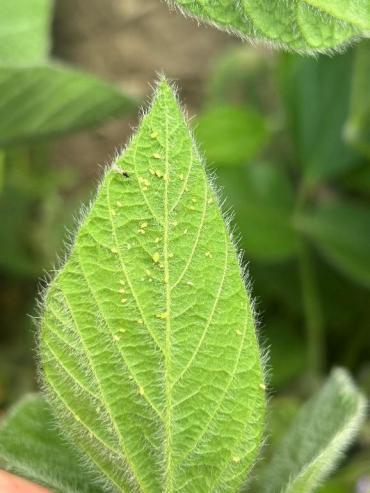By Erin Hodgson
Soybean aphids have been quiet the last few growing seasons in Iowa. This year there have been isolated fields in northern counties that exceeded the economic threshold, but most fields have not warranted insecticides. However, many scouting reports and our observations in northern Iowa counties for the last two weeks show soybean aphids are established. We strongly encourage sampling soybean now to gauge the pressure and make timely treatment decisions.

Photo 1. Infested leaflet from northwest Iowa in 2023 (Photo by Ashley Dean).
Speed Scouting can save time when scouting soybean aphids and does not require absolute counts on soybean plants. However, it is difficult to monitor population dynamics over the season with Speed Scouting. With this method, plants are considered infested if there are 40 or more aphids (this is NOT a new threshold for soybean aphid but has been validated as an alternative sampling method to reduce scouting time). Use the Speed Scouting Worksheet to make treatment and scouting decisions.
- In each 50-acre area of soybean, scout for soybean aphids on 11 plants. Tally the number of infested (≥40 aphids) and uninfested (<40 aphids) plants. Use the worksheet to decide whether to treat the field, not to treat the field, or continue scouting.
- When a treatment decision cannot be made and scouting must continue, continue the process on up to 31 plants. If you still cannot make a treatment decision, resample in three days.
- If treatment is recommended based on Speed Scouting, consider waiting and re-sampling in three days to confirm treatment is still recommended. Speed Scouting may recommend treatment when it is not necessary.
Insecticide resistance is a concern
With any pest and pesticide, repeated exposures will eventually lead to resistance developing in the population. Insecticide resistance is common with aphids, which are asexual, multigenerational pests in many crops. Since 2015, farmers in parts of southern Minnesota have experienced failures of pyrethroid insecticides to control soybean aphid. Entomologists in Minnesota confirmed soybean aphid resistance to bifenthrin and lambda-cyhalothrin.
In 2016, a commercial field in northwest Iowa was suspected to have bifenthrin resistance after being treated twice within two weeks and no reduction in aphids. Vial assays based on the Minnesota protocol also noted increased resistance ratios of a soybean aphid population collected from the problem field. Since then, poor performance of pyrethroids in Minnesota and Iowa fields have been reported. To further complicate management of soybean aphid, chlorpyrifos can no longer be used on field crops. To better understand effective management strategies, read this online, regional factsheet which includes alternative modes of action.
Population fluctuations between locations and years are typical for soybean aphid in Iowa. Regular scouting and timely use of foliar insecticides is still a reliable management tactic.
Helpful tips:
• Use a product labeled for soybean aphid, and use high volume and pressure so that droplets make contact with aphids on the undersides of leaves. Check aphid populations three days after application to assess product efficacy.
• Alternate the mode of action if soybean aphid populations need to be treated twice in a single growing season. Be aware of PHI (pre-harvest intervals) for applications made now.
• Understand that late-season increases in aphids, particularly after R5, may not impact yield like it does during early reproductive growth stages. A foliar insecticide applied after seed set may not be a profitable choice.
Source : iastate.edu